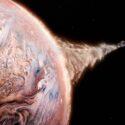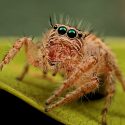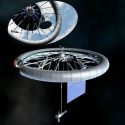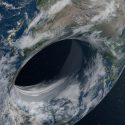It’s almost as old as the Universe, and as massive as 34 billion Suns. It eats stars for breakfast. And now it’s about to consume our own. Behold, the great and powerful black hole with the catchy name J2157.
If it came close enough to our Solar System, how fast would it destroy us? How would it all go sideways for our Sun? And how exactly would this monstrous black hole end all life on Earth?
Black holes are scary enough. They form when big stars explode in a supernova, and then collapse in on themselves. The most common black holes, the stellar ones, are only 16 km (10 mi) in diameter. But they have the mass of a star at least ten times more massive than our Sun crammed in them.
All that mass compressed into such a small diameter makes black holes extremely dense. If you came too close to a black hole’s vicinity, beyond its event horizon, its extreme gravitational pull would turn you into a spaghetti noodle.
But there are black holes so massive that they make stellar black holes look featherlight. These are called supermassive black holes. These monstrosities lurk at the centers of galaxies, and take up space roughly the size of our Solar System. But most of them don’t even get close to the size of black hole J2157.
J2157 is the fastest-growing black hole in the known Universe, and it’s the second largest one. Its event horizon has a radius of 670 astronomical units, which is comparable with the distance between the Sun and Neptune multiplied by 22.
If that’s not scary enough, J2157 holds the title of the hungriest black hole we know of. To stay in good shape, it gobbles up matter at a rate of about one Sun per day. Now, take this monstrosity and bring it closer to our Solar System. You can imagine how that would play out.
If J2157 could replace the supermassive black hole that sits at the center of our Milky Way galaxy, to us on Earth, it would look ten times brighter than the full Moon. That’s because of its incredibly large accretion disk, the matter the black hole collected on its way to us.
And because it always needs to be the center of attention, the monstrous black hole would outshine most of the stars in the sky. If a black hole under 100 million masses of our Sun entered our Solar System, it wouldn’t swallow the Sun in one go. It would gradually start pulling matter from our star, until all that’s left of it would be a cloud of gas.
In that case, you might expect lethal amounts of cosmic radiation headed toward the Earth. But that’s not how J2157 likes to deal with things.
A black hole of that size and mass would devour the Sun in a moment. But losing the Sun would be the least of our problems.
Our planet could be torn apart by the tidal forces from the black hole consuming our Sun. Or, it could be bombarded with an unthinkable amount of cosmic radiation. Or, it would disappear into the black hole’s event horizon, along with the rest of the Solar System.
Either way, you wouldn’t get out of this alive. But no matter how big and scary J2157 is, remember that it sits at a safe distance of 12.5 billion light-years away from us. I’d say we’re pretty safe here.
Sources
- “Hungriest of black holes among the most massive in the universe”. 2020. phys.org.
- “There’s A Black Hole With 34 Billion Times The Mass Of The Sun, Eating Roughly A Star Every Day – Universe Today”. 2020. Universe Today.
- “A Thirty-Four Billion Solar Mass Black Hole In SMSS J2157–3602, The Most Luminous Known Quasar”. Monthly Notices Of The Royal Astronomical Society 496 (2): 2309-2314. doi:10.1093/mnras/staa1635.
- “Discovery Of The Most Ultra-Luminous QSO Using GAIA, Skymapper, And WISE”. Wolf, Christian, Fuyan Bian, Christopher A. Onken, Brian P. Schmidt, Patrick Tisserand, Noura Alonzi, Wei Jeat Hon, and John L. Tonry. 2018. Publications Of The Astronomical Society Of Australia 35. doi:10.1017/pasa.2018.22.
- “What Exactly Is A Black Hole Event Horizon (And What Happens There)?”. Choi, Charles. 2019. space.com.
- “Singularities – Black Holes And Wormholes – The Physics Of The Universe”. 2020. physicsoftheuniverse.com.
- “Stellar Black Holes”. 2013. www.cfa.harvard.edu.




























[…] whatifshow […]